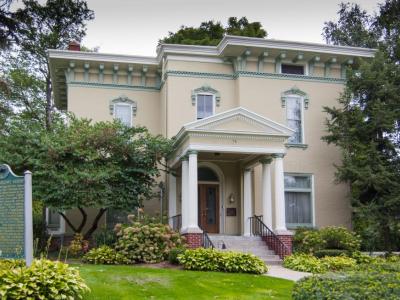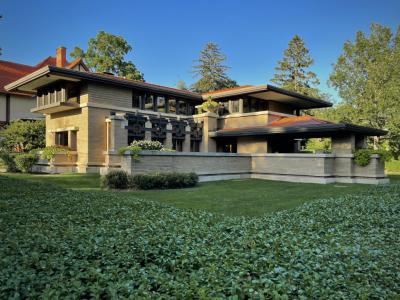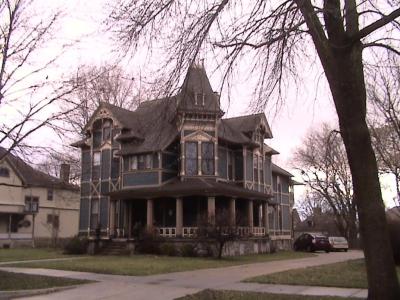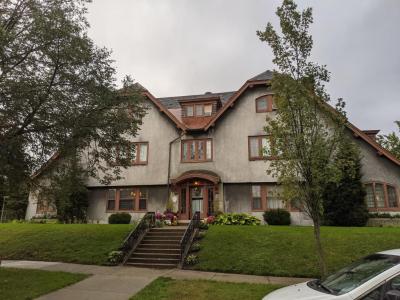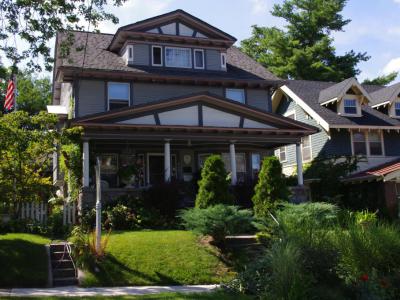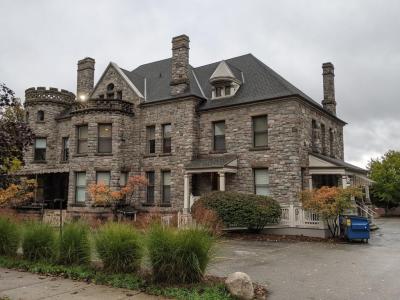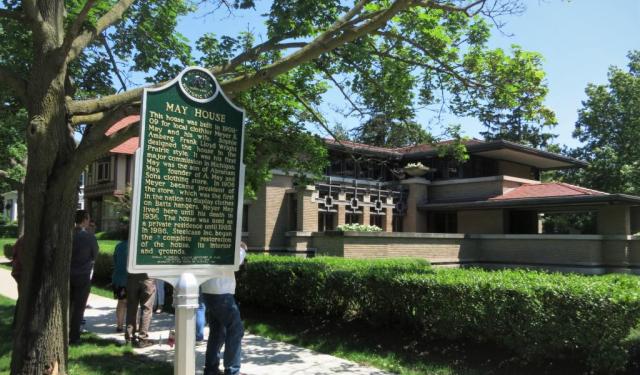
Heritage Hill Historic District Walking Tour (Self Guided), Grand Rapids
Heritage Hill, nestled in the heart of Grand Rapids, Michigan, is the city's oldest residential neighborhood. It is also among the largest urban historic districts in the United States and has been recognized as one of the Great Places in America by the American Planning Association.
Spanning about one square mile and accommodating 4,400 residents, the neighborhood is a living museum of architectural history, holding the largest in Michigan concentration of 19th and early 20th-century architecture. The variety of styles found here spans from Greek- and Colonial Revival to Italianate, Queen Anne, American Craftsman, Shingle, and even a Prairie; each home telling its own unique story.
These properties once belonged to prominent figures such as lumber barons and legislators who shaped Grand Rapids' history. As such, the neighborhood was added to the National Register of Historic Places in 1971. The houses featured in this walk is just a fraction of the multitude of historical homes in the area, totaling over 1,300 and dating back to the 1840s.
The McCabe-Marlowe House, built in the mid-19th century, is a beautiful example of Greek Revival architecture. Its stately columns and balanced proportions reflect the period's elegance. A short walk away, the Voigt House, preserved as a museum, offers a peek into the lavish lifestyle of the late 19th century with its ornate Victorian design and authentic interiors.
Then there’s The Castle, an imposing Chateauesque mansion that lives up to its name, featuring Scottish granite stonework. In contrast, the Meyer May House, designed by Frank Lloyd Wright, represents the sleek, functional beauty of the Prairie School movement. It’s a must-visit for anyone interested in architectural innovation.
For those looking for a place to stay or host events, the Leonard at Logan House combines historic charm with modern hospitality. Finally, the Gerald R. Ford Boyhood Home adds a touch of presidential history to the district, reminding visitors of the roots of one of the country’s leaders.
A stroll through Heritage Hill offers a picturesque glimpse into the lifestyle of a bygone era, making it a fascinating destination for architecture enthusiasts and history lovers alike. So, take this self-guided tour and immerse yourself in the stories these houses have to tell. Your journey into Grand Rapids’ past is waiting to begin!
Spanning about one square mile and accommodating 4,400 residents, the neighborhood is a living museum of architectural history, holding the largest in Michigan concentration of 19th and early 20th-century architecture. The variety of styles found here spans from Greek- and Colonial Revival to Italianate, Queen Anne, American Craftsman, Shingle, and even a Prairie; each home telling its own unique story.
These properties once belonged to prominent figures such as lumber barons and legislators who shaped Grand Rapids' history. As such, the neighborhood was added to the National Register of Historic Places in 1971. The houses featured in this walk is just a fraction of the multitude of historical homes in the area, totaling over 1,300 and dating back to the 1840s.
The McCabe-Marlowe House, built in the mid-19th century, is a beautiful example of Greek Revival architecture. Its stately columns and balanced proportions reflect the period's elegance. A short walk away, the Voigt House, preserved as a museum, offers a peek into the lavish lifestyle of the late 19th century with its ornate Victorian design and authentic interiors.
Then there’s The Castle, an imposing Chateauesque mansion that lives up to its name, featuring Scottish granite stonework. In contrast, the Meyer May House, designed by Frank Lloyd Wright, represents the sleek, functional beauty of the Prairie School movement. It’s a must-visit for anyone interested in architectural innovation.
For those looking for a place to stay or host events, the Leonard at Logan House combines historic charm with modern hospitality. Finally, the Gerald R. Ford Boyhood Home adds a touch of presidential history to the district, reminding visitors of the roots of one of the country’s leaders.
A stroll through Heritage Hill offers a picturesque glimpse into the lifestyle of a bygone era, making it a fascinating destination for architecture enthusiasts and history lovers alike. So, take this self-guided tour and immerse yourself in the stories these houses have to tell. Your journey into Grand Rapids’ past is waiting to begin!
How it works: Download the app "GPSmyCity: Walks in 1K+ Cities" from Apple App Store or Google Play Store to your mobile phone or tablet. The app turns your mobile device into a personal tour guide and its built-in GPS navigation functions guide you from one tour stop to next. The app works offline, so no data plan is needed when traveling abroad.
Heritage Hill Historic District Walking Tour Map
Guide Name: Heritage Hill Historic District Walking Tour
Guide Location: USA » Grand Rapids (See other walking tours in Grand Rapids)
Guide Type: Self-guided Walking Tour (Sightseeing)
# of Attractions: 12
Tour Duration: 2 Hour(s)
Travel Distance: 3.9 Km or 2.4 Miles
Author: nataly
Sight(s) Featured in This Guide:
Guide Location: USA » Grand Rapids (See other walking tours in Grand Rapids)
Guide Type: Self-guided Walking Tour (Sightseeing)
# of Attractions: 12
Tour Duration: 2 Hour(s)
Travel Distance: 3.9 Km or 2.4 Miles
Author: nataly
Sight(s) Featured in This Guide:
- McCabe-Marlowe House
- 422 Fountain St NE
- Albert Stickley House
- McCormick House
- Meyer May House
- Stockwell House
- Leonard at Logan House
- Gerald R. Ford Boyhood Home
- 540 Wealthy Street
- 226 College Ave SE
- The Castle
- Voigt House
1) McCabe-Marlowe House
The McCabe-Marlowe House is a historic treasure built in 1865 by James Gallup, a prominent insurance salesman and drugstore operator. Gallup was deeply involved in the community, serving as U.S. Postmaster from 1878 to 1882 and playing a key role in organizing and pastoring several local churches. Over the years, the house was owned by an array of influential figures, including bankers, lawyers, doctors, and philanthropists, each adding to its storied legacy.
In 1945, the house found a unique purpose when McCabe and Marlowe, two junior college faculty members, acquired it and used it as a venue for hosting teas for biology and chemistry students who aspired to careers in medicine. After decades of distinguished use, the home underwent a meticulous 15-month restoration project, culminating in its designation as a state historic landmark in 1981.
Today, the house retains its historic charm with features like the original oak flooring, an intricately curved cherry staircase inlaid with ivory scrimshaw, and double front doors adorned with etched and frosted glass. An attached carriage house, complete with original wooden barn doors, adds to its historic allure.
Visitors to the McCabe-Marlowe House are greeted by a stunning chandelier that once graced the downtown Pantlind Hotel, alongside impeccably preserved molded plaster medallions in the front parlors. Over the years, this elegant space has served as a venue for conferences, wedding receptions, baby showers, and retreats.
In 1945, the house found a unique purpose when McCabe and Marlowe, two junior college faculty members, acquired it and used it as a venue for hosting teas for biology and chemistry students who aspired to careers in medicine. After decades of distinguished use, the home underwent a meticulous 15-month restoration project, culminating in its designation as a state historic landmark in 1981.
Today, the house retains its historic charm with features like the original oak flooring, an intricately curved cherry staircase inlaid with ivory scrimshaw, and double front doors adorned with etched and frosted glass. An attached carriage house, complete with original wooden barn doors, adds to its historic allure.
Visitors to the McCabe-Marlowe House are greeted by a stunning chandelier that once graced the downtown Pantlind Hotel, alongside impeccably preserved molded plaster medallions in the front parlors. Over the years, this elegant space has served as a venue for conferences, wedding receptions, baby showers, and retreats.
2) 422 Fountain St NE
The house at 422 Fountain St NE is an exquisite example of Shingle Style architecture, built in 1903 for the prominent Widdicomb family, founders of the fine furniture company that shares their name. Owned by the Widdicombs until the 1930s, the home saw various family members and renters reside there before becoming home to two physicians' families in succession.
Davenport College took ownership in 1970, repurposing it as a student dormitory. After decades of wear, the house underwent an extensive restoration beginning in 2005, when the current owners took on the ambitious project to restore its historic charm.
The exterior features a striking combination of clapboard and shingles, an asymmetrical facade with an off-set gable, roof dormers, and an expansive porch that creates a commanding presence on the street. A variety of windows with mullioned patterns on the upper panes enhance its character, while diamond-patterned sidelight windows frame the front door.
Upon entry, visitors are greeted by a grand central staircase adorned with intricate spindles and geometric woodwork. Pocket doors lead to first-floor rooms, blending historic details with modern decor. A reimagined kitchen now occupies the front of the house, featuring cherry cabinetry, glass tile, and an open flow into the dining room, where a built-in cherry hutch and butler’s pantry maintain the home's original charm.
Davenport College took ownership in 1970, repurposing it as a student dormitory. After decades of wear, the house underwent an extensive restoration beginning in 2005, when the current owners took on the ambitious project to restore its historic charm.
The exterior features a striking combination of clapboard and shingles, an asymmetrical facade with an off-set gable, roof dormers, and an expansive porch that creates a commanding presence on the street. A variety of windows with mullioned patterns on the upper panes enhance its character, while diamond-patterned sidelight windows frame the front door.
Upon entry, visitors are greeted by a grand central staircase adorned with intricate spindles and geometric woodwork. Pocket doors lead to first-floor rooms, blending historic details with modern decor. A reimagined kitchen now occupies the front of the house, featuring cherry cabinetry, glass tile, and an open flow into the dining room, where a built-in cherry hutch and butler’s pantry maintain the home's original charm.
3) Albert Stickley House
The Albert Stickley House is a remarkable example of early 20th-century craftsmanship and design. Built in 1900 for Albert Stickley, the founder of the Stickley Brothers Furniture Company, the home was designed to showcase the company's renowned Craftsman furniture. The interior was carefully reconstructed to embody the ideals of the Arts & Crafts movement, making it one of the first interiors in America to fully embrace this style. Its emphasis on simplicity, quality, and craftsmanship continues to draw admiration from design enthusiasts and historians alike.
The house's interior exudes a sense of grandeur, characterized by its spacious layout, attention to detail, and craftsmanship. As described by Samuel Howe in The Craftsman magazine in December 1902, the home reflects a "quiet sense of humanity" and the soul of the workmen who created it. Features such as large, inviting fireplaces epitomize the warmth and comfort central to the Arts & Crafts philosophy.
Today, the Albert Stickley House remains a testament to the enduring appeal of the Arts & Crafts movement. Its historical significance lies not only in its connection to Stickley's pioneering work in furniture design but also in its role as a showcase for the movement's core principles.
The house's interior exudes a sense of grandeur, characterized by its spacious layout, attention to detail, and craftsmanship. As described by Samuel Howe in The Craftsman magazine in December 1902, the home reflects a "quiet sense of humanity" and the soul of the workmen who created it. Features such as large, inviting fireplaces epitomize the warmth and comfort central to the Arts & Crafts philosophy.
Today, the Albert Stickley House remains a testament to the enduring appeal of the Arts & Crafts movement. Its historical significance lies not only in its connection to Stickley's pioneering work in furniture design but also in its role as a showcase for the movement's core principles.
4) McCormick House
The McCormick House showcases a transitional architectural style that bridges the earlier Greek Revival with the later Queen Anne. Its distinctive features include intricate stickwork and porch detailing reminiscent of finely crafted furniture.
Originally built by James J. McCormick, this stately home has been carefully preserved and adapted over the years, blending 19th-century charm with modern conveniences. Nestled atop a hill, the home offers picturesque views, including those of the nearby Saginaw River, and features an expansive porch spanning its width.
Today, the historic property operates as a six-unit apartment building, inviting guests to enjoy both its elegant heritage and contemporary comforts. Visitors can relax on the porch, enjoy a swing on the lawn, or gather on the shared patio at the back of the house. Guests are greeted by a grand staircase in the central foyer, which leads to the apartment’s private entrance. Inside, 7-foot-tall windows and original radiators add period charm, while modern features like blackout shades and a noise machine ensure a comfortable stay.
With its unique combination of historic elegance, modern amenities, and inviting outdoor spaces, the McCormick House offers a memorable retreat in the heart of Grand Rapids.
Originally built by James J. McCormick, this stately home has been carefully preserved and adapted over the years, blending 19th-century charm with modern conveniences. Nestled atop a hill, the home offers picturesque views, including those of the nearby Saginaw River, and features an expansive porch spanning its width.
Today, the historic property operates as a six-unit apartment building, inviting guests to enjoy both its elegant heritage and contemporary comforts. Visitors can relax on the porch, enjoy a swing on the lawn, or gather on the shared patio at the back of the house. Guests are greeted by a grand staircase in the central foyer, which leads to the apartment’s private entrance. Inside, 7-foot-tall windows and original radiators add period charm, while modern features like blackout shades and a noise machine ensure a comfortable stay.
With its unique combination of historic elegance, modern amenities, and inviting outdoor spaces, the McCormick House offers a memorable retreat in the heart of Grand Rapids.
5) Meyer May House (must see)
The Meyer May House, designed by the legendary architect Frank Lloyd Wright, is a stunning example of Prairie-style architecture. Built in 1908–09 for clothier Meyer S. May and his wife Sophie, the house stands as a striking departure from the Victorian-era homes surrounding it. With its low-pitched roof, horizontal lines, and extensive use of leaded glass windows, the home reflects Wright’s vision of blending architecture with the natural environment. The design features block-like masses, pronounced copings, and a harmonious interplay between the walls, ceilings, and floors, embodying Wright’s philosophy of organic architecture.
After years of modifications, the Meyer May House underwent a meticulous two-year restoration led by Steelcase Incorporated, which returned it to its original grandeur. The restoration included reproductions of original furnishings and the recreation of Wright’s intricate leaded glass designs, ensuring the house remains a pristine example of his Prairie School era. Visitors can admire the 108 windows and skylights that fill the interior with natural light, creating an ever-changing interplay of light and shadow. The living room, with its clerestory windows and skylights, exemplifies Wright's innovative approach, seamlessly integrating architectural elements with the surrounding landscape.
Today, the Meyer May House offers free public tours, allowing visitors to step back in time and experience early 20th-century elegance. Guests can explore the meticulously restored interiors, stroll through the recreated grounds, and watch a film chronicling the house’s history and restoration. Known as "Michigan's Prairie masterpiece," the Meyer May House not only showcases Wright's architectural genius but also provides a fascinating glimpse into the lives of Grand Rapids' affluent residents during the early 1900s.
After years of modifications, the Meyer May House underwent a meticulous two-year restoration led by Steelcase Incorporated, which returned it to its original grandeur. The restoration included reproductions of original furnishings and the recreation of Wright’s intricate leaded glass designs, ensuring the house remains a pristine example of his Prairie School era. Visitors can admire the 108 windows and skylights that fill the interior with natural light, creating an ever-changing interplay of light and shadow. The living room, with its clerestory windows and skylights, exemplifies Wright's innovative approach, seamlessly integrating architectural elements with the surrounding landscape.
Today, the Meyer May House offers free public tours, allowing visitors to step back in time and experience early 20th-century elegance. Guests can explore the meticulously restored interiors, stroll through the recreated grounds, and watch a film chronicling the house’s history and restoration. Known as "Michigan's Prairie masterpiece," the Meyer May House not only showcases Wright's architectural genius but also provides a fascinating glimpse into the lives of Grand Rapids' affluent residents during the early 1900s.
6) Stockwell House
The Stockwell House is a stunning example of high-style Queen Anne architecture. Built in 1882 for A. E. Stockwell, the home features hallmark elements of the Queen Anne style, including a steeply pitched roof, an asymmetrical front façade, and a prominent corner tower. Its decorative details are primarily influenced by the Eastlake style, complemented by intricate stick-work trim that adds to its visual appeal. Originally a single-family home, the property was converted into apartments in the 1950s but has since been meticulously restored to its original purpose.
The house's first occupant, A. E. Stockwell, was a notable figure in the Grand Rapids community. A lumberman and partner in the Stockwell & Darragh Furniture Company, he lived in the home until 1890 when it was sold to John B. Martin I. Martin, whose family had ties to Grand Rapids' early development—his father collaborated with founding father John Ball in the freight business—was a successful real estate entrepreneur. The Martin family lived in the home until 1940, leaving a legacy intertwined with the city’s history.
Notably, John B. Martin I's son, John B. Martin II, achieved significant success in politics and served with distinction in the U.S. Navy. His role in secret service operations in Europe during World War II, as well as his attendance at the Nuremberg Trials, highlights the family's prominent contributions on both local and international stages. Today, the Stockwell House stands as a beautifully preserved piece of Grand Rapids' architectural and historical heritage.
The house's first occupant, A. E. Stockwell, was a notable figure in the Grand Rapids community. A lumberman and partner in the Stockwell & Darragh Furniture Company, he lived in the home until 1890 when it was sold to John B. Martin I. Martin, whose family had ties to Grand Rapids' early development—his father collaborated with founding father John Ball in the freight business—was a successful real estate entrepreneur. The Martin family lived in the home until 1940, leaving a legacy intertwined with the city’s history.
Notably, John B. Martin I's son, John B. Martin II, achieved significant success in politics and served with distinction in the U.S. Navy. His role in secret service operations in Europe during World War II, as well as his attendance at the Nuremberg Trials, highlights the family's prominent contributions on both local and international stages. Today, the Stockwell House stands as a beautifully preserved piece of Grand Rapids' architectural and historical heritage.
7) Leonard at Logan House
The Leonard at Logan House is a historic Bed & Breakfast located in the charming Heritage Hill neighborhood. Built in 1914 during a time of prosperity and social transformation, this beautifully preserved home was commissioned by the influential Leonard family, known for their refined taste and gracious hospitality. The home's architecture reflects the family's understated elegance, creating a warm and inviting space that has stood the test of time. As one of the largest urban historic districts in the United States, Heritage Hill provides a stunning backdrop for this unique accommodation.
Today, the Leonard at Logan House offers an alternative to traditional hotel stays, combining historic charm with modern comfort. Its carefully curated interiors, featuring period-appropriate details, evoke a sense of timelessness, while its welcoming atmosphere ensures a memorable stay for both business and leisure travelers. The B&B is renowned for its romantic ambiance and has been recognized as one of the Top 10 Romantic Accommodations in Michigan, making it a favorite choice for couples seeking an intimate getaway.
Whether you're drawn to the historic setting, the personalized service, or the cozy elegance of the inn, a visit to this exceptional B&B promises an experience filled with warmth, charm, and lasting memories. Moreover, the house is situated right in the middle of Heritage Hill and is just a 4-minute drive or a 12-minute walk to downtown Grand Rapids, making it an excellent base for exploring the city.
Today, the Leonard at Logan House offers an alternative to traditional hotel stays, combining historic charm with modern comfort. Its carefully curated interiors, featuring period-appropriate details, evoke a sense of timelessness, while its welcoming atmosphere ensures a memorable stay for both business and leisure travelers. The B&B is renowned for its romantic ambiance and has been recognized as one of the Top 10 Romantic Accommodations in Michigan, making it a favorite choice for couples seeking an intimate getaway.
Whether you're drawn to the historic setting, the personalized service, or the cozy elegance of the inn, a visit to this exceptional B&B promises an experience filled with warmth, charm, and lasting memories. Moreover, the house is situated right in the middle of Heritage Hill and is just a 4-minute drive or a 12-minute walk to downtown Grand Rapids, making it an excellent base for exploring the city.
8) Gerald R. Ford Boyhood Home
The Gerald R. Ford Boyhood Home is a preserved Colonial Revival house that holds significant historical importance. Built around 1910, this 2½-story weatherboarded home is noted for its charming architecture, including a front porch supported by sturdy pillars, side gabled roofs, and a prominent wide dormer. Gerald R. Ford, the 38th President of the United States, lived in this house from 1921 to 1930, between the ages of 8 and 17. The home is situated in the historic Heritage Hill neighborhood, an area known for its architectural richness.
Ford remembered this residence most vividly among his boyhood homes, as he described in his autobiography. It was here that he internalized life lessons from his family, such as the importance of hard work, honesty, and discipline. During his years at the Union Avenue house, Ford attended Madison School and later South High School, where he excelled in academics and athletics, earning All-State honors as a football center. The garage at the back of the house became a favorite hangout spot for Ford and his friends, who used the upper level as a secret club where they played penny-ante poker—a hideaway his parents rarely visited.
The home underwent a meticulous exterior restoration in 2013, which involved seven paint colors and more than 500 hours of work, ensuring its historical authenticity. Today, the house stands as a testament to Ford’s early life and the values he carried into his political career, which included serving as a U.S. Representative for Grand Rapids from 1949 to 1973 and later becoming President of the United States.
Ford remembered this residence most vividly among his boyhood homes, as he described in his autobiography. It was here that he internalized life lessons from his family, such as the importance of hard work, honesty, and discipline. During his years at the Union Avenue house, Ford attended Madison School and later South High School, where he excelled in academics and athletics, earning All-State honors as a football center. The garage at the back of the house became a favorite hangout spot for Ford and his friends, who used the upper level as a secret club where they played penny-ante poker—a hideaway his parents rarely visited.
The home underwent a meticulous exterior restoration in 2013, which involved seven paint colors and more than 500 hours of work, ensuring its historical authenticity. Today, the house stands as a testament to Ford’s early life and the values he carried into his political career, which included serving as a U.S. Representative for Grand Rapids from 1949 to 1973 and later becoming President of the United States.
9) 540 Wealthy Street
The house at 540 Wealthy Street is a beautifully restored example of the American Craftsman style, originally built in 1875 by Henry Fairchild. Known for its exceptional craftsmanship and intricate attention to detail, the home’s architectural charm is evident in its complex facade, featuring bay windows, embellished gables, a multi-angled roofline, and three detailed porches.
After decades of neglect, the property underwent a meticulous restoration led by Red Lobby Design Firm in 2017, including the painstaking six-month reconstruction of its front door. The current owners purchased the impeccably restored home in 2022, preserving its historical integrity while enjoying its modernized features.
Inside, the home welcomes visitors with a vestibule featuring the house number embedded in the floor tile and a stylized floral carving on the newel post. The interior boasts 10-foot ceilings, floor-to-ceiling windows, and refinished oak floors that reflect the abundant natural light. Unique design elements such as geometric woodwork patterns, ornate hinges, and sliding doors add to its character.
The living room centers around a hearth, while the dining room seamlessly blends new additions like built-in bookcases and a private porch with the original woodwork. The kitchen has been tastefully remodeled, incorporating original windows and parquet flooring from the 1920s, complemented by cherry cabinets and brass drawer pulls for a timeless aesthetic.
The upper levels maintain the home’s historic charm with original wide-plank pine flooring and a mix of functional and luxurious spaces. The second floor features three bedrooms, an exercise room, two baths, and a laundry room, with the primary suite offering a bay window and a marble-finished bath. The attic provides a playful retreat with a pool table, bar, and pinball machine, while the backyard includes a newly constructed garage and a bomb shelter.
After decades of neglect, the property underwent a meticulous restoration led by Red Lobby Design Firm in 2017, including the painstaking six-month reconstruction of its front door. The current owners purchased the impeccably restored home in 2022, preserving its historical integrity while enjoying its modernized features.
Inside, the home welcomes visitors with a vestibule featuring the house number embedded in the floor tile and a stylized floral carving on the newel post. The interior boasts 10-foot ceilings, floor-to-ceiling windows, and refinished oak floors that reflect the abundant natural light. Unique design elements such as geometric woodwork patterns, ornate hinges, and sliding doors add to its character.
The living room centers around a hearth, while the dining room seamlessly blends new additions like built-in bookcases and a private porch with the original woodwork. The kitchen has been tastefully remodeled, incorporating original windows and parquet flooring from the 1920s, complemented by cherry cabinets and brass drawer pulls for a timeless aesthetic.
The upper levels maintain the home’s historic charm with original wide-plank pine flooring and a mix of functional and luxurious spaces. The second floor features three bedrooms, an exercise room, two baths, and a laundry room, with the primary suite offering a bay window and a marble-finished bath. The attic provides a playful retreat with a pool table, bar, and pinball machine, while the backyard includes a newly constructed garage and a bomb shelter.
10) 226 College Ave SE
The house at 226 College Ave SE is a beautiful example of American Craftsman architecture, built in 1891 by Phillip Klingman, president of the Klingman Furniture Companies. Over the years, it has passed through the hands of prominent owners, including machinist Victor M. Tuthill and attorney Wencel Milanowski, whose family retained ownership until 2010. Legend has it that Margueritte Milanowski, Wencel’s wife, still “visits” the home, adding a touch of mystery to its rich history.
The home’s exterior exudes character, featuring a spacious front porch, a prominent gable adorned with a Palladian window, and intricate leaded and stained glass windows. The bay windows enhance its architectural appeal, while future plans to remove the siding promise to further reveal its original charm.
Inside, the main floor showcases exquisite craftsmanship. A pocket door with wood surfaces tailored to match the rooms it separates exemplifies attention to detail. The dining room is particularly captivating with oak paneling, a parquet floor, a bay window, and antique furniture originally owned by the Klingman family. A large fireplace with a rare blood marble surround serves as the room's focal point, complemented by a period chandelier.
Other highlights of the interior include the butler’s pantry with its original cabinetry and a completely renovated kitchen. The library is a masterpiece, with mahogany wainscoting, built-in bookcases, and another fireplace featuring blood marble. The grand staircase, adorned with a beautifully carved and beaded newel post, leads to the second floor, where a magnificent floral stained glass window on the landing captures attention.
The home’s exterior exudes character, featuring a spacious front porch, a prominent gable adorned with a Palladian window, and intricate leaded and stained glass windows. The bay windows enhance its architectural appeal, while future plans to remove the siding promise to further reveal its original charm.
Inside, the main floor showcases exquisite craftsmanship. A pocket door with wood surfaces tailored to match the rooms it separates exemplifies attention to detail. The dining room is particularly captivating with oak paneling, a parquet floor, a bay window, and antique furniture originally owned by the Klingman family. A large fireplace with a rare blood marble surround serves as the room's focal point, complemented by a period chandelier.
Other highlights of the interior include the butler’s pantry with its original cabinetry and a completely renovated kitchen. The library is a masterpiece, with mahogany wainscoting, built-in bookcases, and another fireplace featuring blood marble. The grand staircase, adorned with a beautifully carved and beaded newel post, leads to the second floor, where a magnificent floral stained glass window on the landing captures attention.
11) The Castle
The Castle is a striking example of Chateauesque-style architecture. Built between 1884 and 1886, it was designed by prominent local architect William G. Robinson for the wealthy lumber barons Colonel E. Crofton Fox and his brother Charles. Constructed from imported Scottish granite, the building’s castle-like appearance is accentuated by intricate leaded and stained glass windows, a finely crafted metal dormer resembling stone, and a grand carved oak staircase. Its parquet flooring in the entry hall adds to the opulence of its interior design. This iconic landmark has been a registered Michigan Historical Site and a defining feature of the Heritage Hill Historic District.
The Fox brothers, Ethelbert Crofton (1852–1904) and Charles (1853–1915), were influential figures in the lumber industry through their firm, Osterhout, Fox & Company. Their wealth allowed them to commission this impressive home. Beyond their business pursuits, Colonel E. Crofton Fox was deeply involved in public service, serving on the State Military Board and as treasurer of the City Board of Trade. Charles Fox also left his mark on the city by founding the Michigan Trust Company in 1889, a cornerstone of Grand Rapids' financial history. Together, they created a residence that symbolized their success and standing in the community.
Over the years, The Castle has adapted to changing times. It was converted into a restaurant in 1978, blending historic charm with modern utility. As of 2019, the building served as the home of Stonecastle Dentistry, continuing to function as a vibrant part of the community. Situated just blocks from another architectural gem, the Frank Lloyd Wright-designed Meyer May House, The Castle remains a celebrated piece of Grand Rapids’ architectural and cultural heritage.
The Fox brothers, Ethelbert Crofton (1852–1904) and Charles (1853–1915), were influential figures in the lumber industry through their firm, Osterhout, Fox & Company. Their wealth allowed them to commission this impressive home. Beyond their business pursuits, Colonel E. Crofton Fox was deeply involved in public service, serving on the State Military Board and as treasurer of the City Board of Trade. Charles Fox also left his mark on the city by founding the Michigan Trust Company in 1889, a cornerstone of Grand Rapids' financial history. Together, they created a residence that symbolized their success and standing in the community.
Over the years, The Castle has adapted to changing times. It was converted into a restaurant in 1978, blending historic charm with modern utility. As of 2019, the building served as the home of Stonecastle Dentistry, continuing to function as a vibrant part of the community. Situated just blocks from another architectural gem, the Frank Lloyd Wright-designed Meyer May House, The Castle remains a celebrated piece of Grand Rapids’ architectural and cultural heritage.
12) Voigt House
The Voigt House, built in 1896, is a remarkable Victorian mansion that offers a glimpse into the elegance of the late Victorian era. Designed by renowned local architect William G. Robinson, the house draws inspiration from the French chateaux at Chenonceaux, showcasing exquisite architectural details. The home was constructed for Carl G. A. Voigt, a prominent businessman who operated a mill and dry goods store before taking full ownership of the milling works in 1902. The Voigt family lived in the house for over 76 years, preserving its historical integrity by refraining from any remodeling after 1907.
After the passing of Ralph Voigt, the last family member to reside in the home, it was donated to the Grand Rapids Foundation in 1971. By 1974, the property was transformed into a museum, with its richly adorned interior featuring original furnishings and possessions of the Voigt family. Visitors marveled at the house's opulent décor, a true reflection of Victorian tastes and the family's refined lifestyle. The home's preservation made it a rare time capsule, offering a direct connection to the aesthetics and domestic life of the late 19th and early 20th centuries.
Though the museum has been closed since 2009, the Voigt House remains a historically significant landmark. Its enduring legacy as a meticulously preserved Victorian mansion continues to symbolize Grand Rapids' rich architectural and cultural heritage, attracting admiration from historians and architecture enthusiasts alike.
After the passing of Ralph Voigt, the last family member to reside in the home, it was donated to the Grand Rapids Foundation in 1971. By 1974, the property was transformed into a museum, with its richly adorned interior featuring original furnishings and possessions of the Voigt family. Visitors marveled at the house's opulent décor, a true reflection of Victorian tastes and the family's refined lifestyle. The home's preservation made it a rare time capsule, offering a direct connection to the aesthetics and domestic life of the late 19th and early 20th centuries.
Though the museum has been closed since 2009, the Voigt House remains a historically significant landmark. Its enduring legacy as a meticulously preserved Victorian mansion continues to symbolize Grand Rapids' rich architectural and cultural heritage, attracting admiration from historians and architecture enthusiasts alike.
Walking Tours in Grand Rapids, Michigan
Create Your Own Walk in Grand Rapids
Creating your own self-guided walk in Grand Rapids is easy and fun. Choose the city attractions that you want to see and a walk route map will be created just for you. You can even set your hotel as the start point of the walk.
Grand Rapids Introduction Walking Tour
Grand Rapids, Michigan, has a name that speaks to its natural origins and a vibrant present-day identity. Located along the Grand River, the city’s name comes from the river’s swift currents and large size, which once provided a key transportation route for Native Americans and early settlers. Due to the river's prominence, many local businesses and civic organizations use the moniker... view more
Tour Duration: 2 Hour(s)
Travel Distance: 3.0 Km or 1.9 Miles
Tour Duration: 2 Hour(s)
Travel Distance: 3.0 Km or 1.9 Miles
The Most Popular Cities
/ view all
